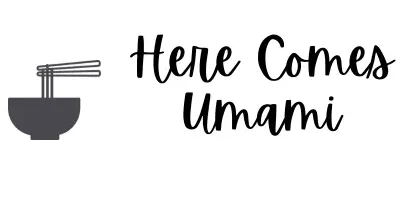How to Make Easy Osaka-Style Okonomiyaki Recipe (Japanese Savory Pancake)

What is Okonomiyaki?
In Australia, okonomiyaki is often called a Japanese savory pancake. The name comes from the Japanese words “okonomi” (お好み), meaning “as you like it,” and “yaki” (焼き), meaning “grilled” or “cooked.” Okonomiyaki is a popular street food in Japan, easily found at food stalls, casual restaurants, and festivals. It’s also commonly made at home, where families enjoy customizing it with their favorite ingredients.
This hearty, filling dish is packed with umami flavors and often includes a batter made of flour, cabbage, and toppings like pork, seafood, or cheese, finished with savory sauces and Japanese mayonnaise.
The history of okonomiyaki dates back to the early 20th century, but its popularity surged after World War II. During the post-war period, food shortages were rampant, and people relied on American-imported flour to create affordable meals. By combining basic ingredients with creativity, okonomiyaki emerged as a versatile and nourishing dish. Over time, it evolved into one of Japan’s most beloved street foods, cherished for its customizable and communal nature.
Okonomiyaki usually consists of a batter made from wheat flour, eggs, dashi (Japanese soup stock), and shredded cabbage. It can include a variety of ingredients such as pork belly, squid, shrimp, or cheese, depending on personal preference. Once cooked, it is topped with okonomiyaki sauce (a sweet and savory condiment), Japanese mayonnaise, bonito flakes, and aonori (seaweed flakes).
What can I do if I cannot find Okonomiyaki sauce?
No worries! I created the recipe for homemade Okonomiyaki sauce.
Can I make it Vegetarian?
Absolutely! You can omit any meat or seafood and replace it with cheese, fried tofu, or any ingredient you prefer. If you’re making a vegetarian version, be sure to create your own homemade okonomiyaki flour to avoid non-vegetarian additives like dashi powder found in pre-made mixes. Customize it to your liking and enjoy!
Osaka style Okonomiyaki vs Hiroshima style Okonomiyaki
The difference between them is how you prepare batter and structure it.
Osaka-style– batter is pre mixed before grilling so it is a lot simpler and quicker to make.
Hiroshima style – thin batter is placed on grill (like crepe) and then top with cabbage, toppings and often noodles.
Today, I’m making a quick and easy Osaka-style Okonomiyaki using pre-made okonomiyaki flour. This recipe is perfect for beginners, as it’s straightforward and simple to follow. The pre-made flour is already infused with umami-rich dashi, ensuring a flavorful and fail-proof dish every time! Whether you’re new to Japanese cooking or simply craving authentic okonomiyaki, this recipe makes it effortless to enjoy this beloved comfort food at home.
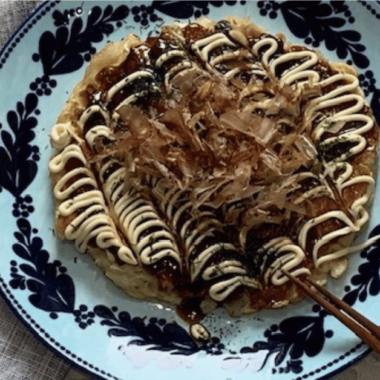
Osaka Style Okonomiyaki – Japanese Savoury Pancake
Ingredients
Okonomiyaki Batter
- 50 grams Pre-made Okonomiyaki flour
- 1 Egg
- 60 ml water
For Okonomiyaki
- 100 grams Cabbage Finely chopped
- 3 tbsp Spring Onion Finely chopped
- 1 tbsp Tenkasu
- 10 grams Beni shoga
- 1 Egg
- 50 grams Pork Belly, Squid, Shrimp Choice of your protein
Topping
- Okonomiyaki sauce
- Mayonaise
- Aonori
- Dried Bonito Flake
Instructions
- Chop 100 grams Cabbage and 3 tbsp Spring Onion finely – please see photos
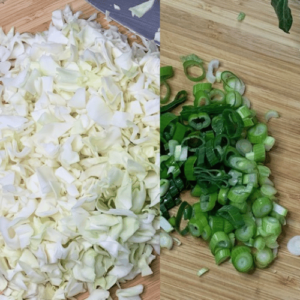
- Mix pre-50 grams Pre-made Okonomiyaki flour and 60 ml water
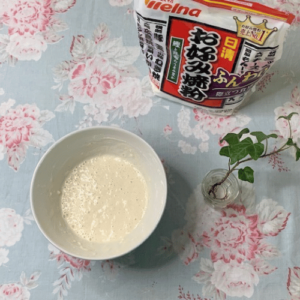
- Add cabbage, spring onion, 1 tbsp Tenkasu, 10 grams Beni shoga and 1 Egg into batter and mix them roughly – don't over mix
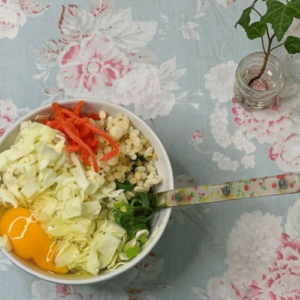
- Heat the frying pan for 200 °Cto 220 °C
- Add oil and batter into the pan when the it is hot , make a hole in the middle, crack an egg into the hole and place your choice of protein on the top of mixed batter
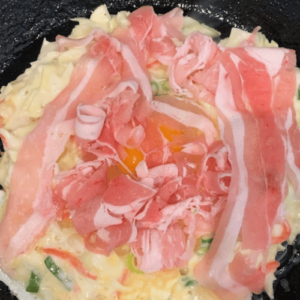
- Place the lid and lower the temperature to low and cook for 4 to 5 minutes – do not press batter even you are tempted
- Flip it when the edge of batter is yellow and firm, place the lid and cook for 4 to 5 minutes – do not press batter
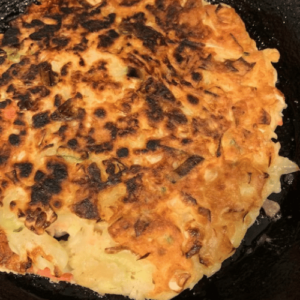
- Flip it again and place it on the plate
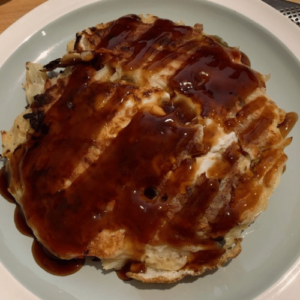
- Dress with yummy Okonomiyaki sauce, Japanese mayo, aonori and dry bonito flake
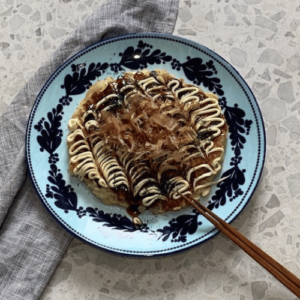
Notes
- You can easily scale this recipe for more people by multiplying the ingredients, but be sure to mix each batch of batter individually.
- For fluffy and light okonomiyaki, mix the batter roughly in a small bowl to avoid overmixing, which can make it dense.
- If you prefer more cabbage in your okonomiyaki, feel free to increase the amount, but keep in mind that adding too many fillings can make the pancake harder to hold together. Handle it gently during cooking for the best results.
